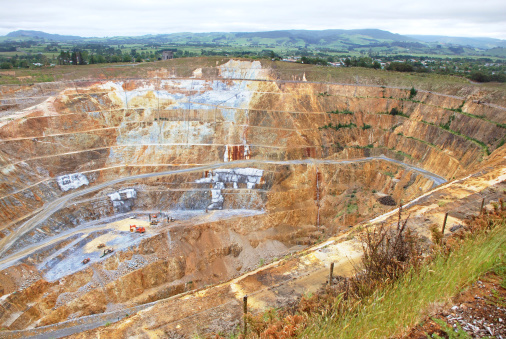Commodities & Metals
Unlikely Bedfellows: Mines That Run on Solar or Wind Power
Published:
By Andrew Topf of Oilprice.com
Mining companies are often seen as dinosaurs when it comes to making changes that will benefit the environment, but that perception may be shifting as some companies turn to renewable energy to cut costs and lighten their carbon footprint.
At first blush, mining and renewable energy seem incongruous. Mining’s reputation as a voracious consumer of fossil fuels is well deserved, especially surface mining, where diesel-sucking haul trucks perform endless loops to and from gigantic pits scraped ever-deeper by immense earth-moving machines belching greenhouse gases.
Contrast that with solar panel installations, with their acres of gleaming panels and gently humming generators, or wind farms, where silent spinning blades crank out megawatts of emissions-free power.
But as the cost of diesel fuel and electricity continues to rise, mining companies are searching for ways to cut their energy bill, and renewables are looking increasingly attractive. The main reason is cost. Choosing renewable energy, especially in an industrial setting, used to be cost-prohibitive, but that is starting to change, in some cases dramatically.
CleanTechnica reported last week that for systems with the right economies of scale — 10 megawatts or higher — solar power can now be generated for between $70 and $100 per megawatt hour. That is four times lower than in 2009. China and the United States both have plans to make solar competitive with coal-powered electricity within a few years.
Another reason is security of supply. Mines are often located in remote areas where grid power is spotty and more costly than in cities. In South Africa, a shortage of power in 2008 caused rolling blackouts, causing several mines to shut down. Two years ago, Egyptian mining company Centamin had to temporarily close its Sukari gold mine due to a dispute with its diesel fuel supplier.
Running a mine on renewables, often in combination with fossil fuels, offers mining companies a way to own and control their own power supplies. Excess power generated by solar and wind at mines can be sold to utility companies, offsetting costs.
Lastly, using renewables in their operations is a way for mining companies to change their reputation as something of eco-pariahs, which can only help their relations with governments and host communities.
South African miners staring at the sun
If there is a test case for using solar to power mines, it is South Africa. The country receives over 2,500 hours of sun a year, but what really makes the mining powerhouse a candidate for solar is the increasing costs of electricity. As mentioned, South Africa suffered blackouts in 2008, and its power utility, Eskom, is doing everything it can to ensure that doesn’t happen again. The result has been a 25 percent annual rise in electricity prices over the last six years; for the next five years, Eskom is allowed to increase rates by 8 percent a year.
South Africa’s miners are fighting back with solar. German mining company CRONIMET was the first to connect solar power to the grid at its Thaba chromium mine in Limpopo province. The 1-megawatt solar facility supplements the mine’s diesel-based power system. CRONIMET says it used to consume almost 2 million litres of diesel fuel a year. Since installing its hybrid PV-solar system in 2012, the company has cut its diesel bill by half a million dollars.
Harmony Gold, South Africa’s third largest gold miner, has also started working solar into its electricity mix. According to PV Insider, the company has started building a 5- to 7-megawatt solar park in Free State province, and another 18-MW facility in North West province, with the goal of alleviating pressure on peak energy usage.
Over in Tanzania, African Barrick Gold is exploring the possibility of using solar power at its Bulyanhulu mine, Mining Weekly reports. The company has also looked to move away from diesel-generated power by tapping into the state-run power utility, which uses a combination of hydro, natural gas and thermal energy. African Barrick Gold expects solar could give its three mines in Tanzania 18 percent of their power needs.
And then there’s wind
Wind power is also being tried by mining companies intent on slashing electricity bills. Vale, the world’s third largest mining company by market value, has formed a joint venture with Australian company Pacific Hydro to build and operate two wind farms in Brazil’s northeast.
Vale, a major iron ore producer, is expecting its demand for electricity to jump 150 percent by 2020. In a press release, the Brazil-based company said it wants to use hydro, wind and biomass to help meet that demand, as well as to diversity its energy mix, reduce emissions and cut costs.
As mining companies continue to evaluate their power options in an era of higher diesel fuel and electricity costs, it is interesting to contemplate whether they could one day foresee operating in an environment more weighted towards renewables than conventional energy. While that seems far-fetched now, considering the amount of equipment and plant machinery that relies on conventional power and fuel, the examples cited here show that renewables are already finding increasing currency among the world’s major miners.
They also demonstrate that mining companies are not oblivious to broader environmental issues, and are willing to make changes in the direction of renewables, especially if there is a motivation to cut costs.
Are you ready for retirement? Planning for retirement can be overwhelming, that’s why it could be a good idea to speak to a fiduciary financial advisor about your goals today.
Start by taking this retirement quiz right here from SmartAsset that will match you with up to 3 financial advisors that serve your area and beyond in 5 minutes. Smart Asset is now matching over 50,000 people a month.
Click here now to get started.
Thank you for reading! Have some feedback for us?
Contact the 24/7 Wall St. editorial team.